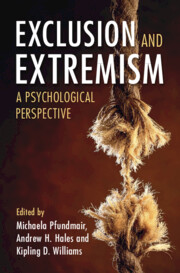Book contents
- Exclusion and Extremism
- Exclusion and Extremism
- Copyright page
- Dedication
- Contents
- Contributors
- Introduction
- Part I The Link between Exclusion and Extremism
- Part II Drivers of the Exclusion–Extremism Link
- 6 Extremism and Exclusion
- 7 Divided Groups, Polarized Identities, and Extremist Behavior
- 8 It’s the Group, Not Just the Individual
- 9 “Who Do They Think We Are?!”
- 10 The Exclusion–Extremism Link in Non-WEIRD Populations
- Part III Topics Related to the Exclusion–Extremism Link
- Index
- References
10 - The Exclusion–Extremism Link in Non-WEIRD Populations
from Part II - Drivers of the Exclusion–Extremism Link
Published online by Cambridge University Press: 16 May 2024
- Exclusion and Extremism
- Exclusion and Extremism
- Copyright page
- Dedication
- Contents
- Contributors
- Introduction
- Part I The Link between Exclusion and Extremism
- Part II Drivers of the Exclusion–Extremism Link
- 6 Extremism and Exclusion
- 7 Divided Groups, Polarized Identities, and Extremist Behavior
- 8 It’s the Group, Not Just the Individual
- 9 “Who Do They Think We Are?!”
- 10 The Exclusion–Extremism Link in Non-WEIRD Populations
- Part III Topics Related to the Exclusion–Extremism Link
- Index
- References
Summary
Being left out by others is a painful experience that threatens basic needs. When people are excluded, they may merely distance themselves from those who have wronged them to avoid further rejection. However, some individuals may engage in compensatory actions to defend their self, their group, or the interplay between them in a way that could be a first step for radicalization leading to violence. How and when people opt for each strategy might vary depending on psychosocial mechanisms as well was macro-level cultural differences. Here, we focus on a mechanism useful for capturing who is more willing to fight or flee under social exclusion – identity fusion, a profound alignment between the personal self and a group, individual, value, or ideological conviction – and on a global cultural factor of relevance for the link between exclusion and extremism, as it is the distinction between WEIRD and non-WEIRD populations.
Keywords
- Type
- Chapter
- Information
- Exclusion and ExtremismA Psychological Perspective, pp. 212 - 236Publisher: Cambridge University PressPrint publication year: 2024

